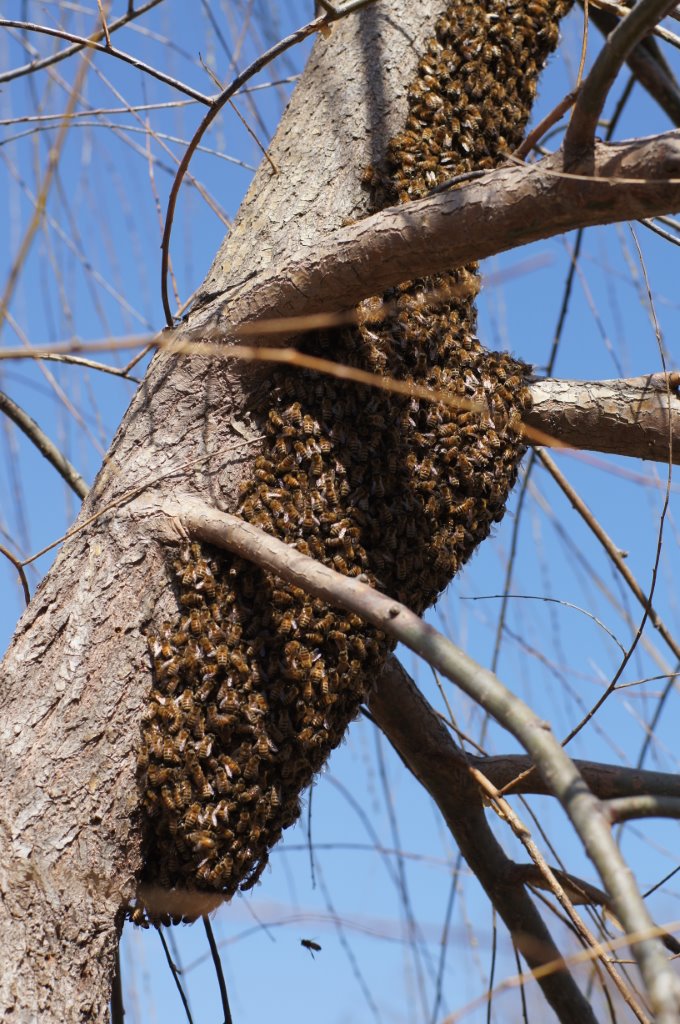BEE / SWARM REMOVAL
What is a swarm?Swarming is a process caused by congestion in the hive. Early in the spring, the population in the hive can greatly expand, creating overcrowding. As a result, the colony makes a decision to divide. The colony begins the process of producing a second queen. When the development of a new queen is well under way, the existing queen and approximately half of the colony will leave the hive and begin looking for a new home. |
Who should I call to have a swarm removed?
If you have a swarm and would like to contact a beekeeper for removal, you may contact someone from the Bee/Swarm Removal List below. Those listed are solely responsible for all actions and activities related to swarm collection. Midwestern Beekeepers Association provides the listing only as a service to the general public and the Assoc. , its officers and members assume no responsibilities whatsoever related to ensuing communications or any transactions that may occur, including but not limited to information exchanged or any damages, injuries or bodily harm alleged to have been sustained during the process of swarm retrieval. When calling, please be prepared to answer the following questions;
- 1. How big is the swarm cluster and what does it look like? Honey bees cluster as one big mass of bees as shown in the picture at the top of the page. If they are a small cluster around the knot of a tree or a hole in a wall, they are no longer a swarm, but an established hive which makes it much more difficult and time consuming to remove.
- 2. Where is swarm located and how high is it? Height usually adds to the difficulty of removal. This lets the beekeeper know what kind of equipment he/she will need, ladders, poles, etc.
- 3. How long has the swarm been there? Swarms that have been there, more than a few days are most likely an established hive. While many beekeepers will remove swarms, far fewer are prepared to handle established hives, including those in trees, houses or other structures.
2024 BEE / SWARM REMOVAL LIST
| Harold Wright | Blue Springs, Lake Lotawana, Grain Valley, Oak Grove, Buckner | 816-286-9217, 816-578-4460 | Swarms and Some Cut-outs |
| Bob and Michelle Williams | Belton, Raymore, Peculiar, Lee’s Summit, Harrisonville, South KC | 816-331-6634 | Swarms and Some Cut-outs |
| Tom and Janice Britz | Harrisonville, MO; Peculiar, Mo | 816-419-6816, 816-419-1327 | Swarms and Some Cut-outs |
| Phil Duncan | Harrisonville, MO | 816-835-7686 | Swarms only |
| Struart and Nita Dietz | Independence, MO and Topeka, Kansas | 785-304-5905 | Swarms and Cut-outs |
| Kirsten Hollstrom | Kansas City, MO | 816-686-2316 | Swarms only |
| Marty Hansen | Belton, Raymore, Peculiar, Lee’s Summit, Harrisonville,South KC | 816-863-1974 | Swarms only |
| Jim and Tanya Fisher | Raymore, Grandview, Lee’s Summit | 816-918-6648 | Swarms only |
| Lenora Woolsey | Independence, MO | 913-907-0574 | Swarms only |
| Ezekiel Amador | Kansas City, MO Midtown/Downtown | 816-612-9030 | Swarms and Some Cut-outs |
| Ron Vivian | Oak Grove, MO | 816-582-6934 | Swarms only |
| Connie Unzicker | St. Joseph, MO | 816-390-2357 | Swarms only |
| Michael Costanzo | Kearney/Holt/Liberty/Lathrop/Lawson | 816-918-9865 | Swarms and some cut-outs |

